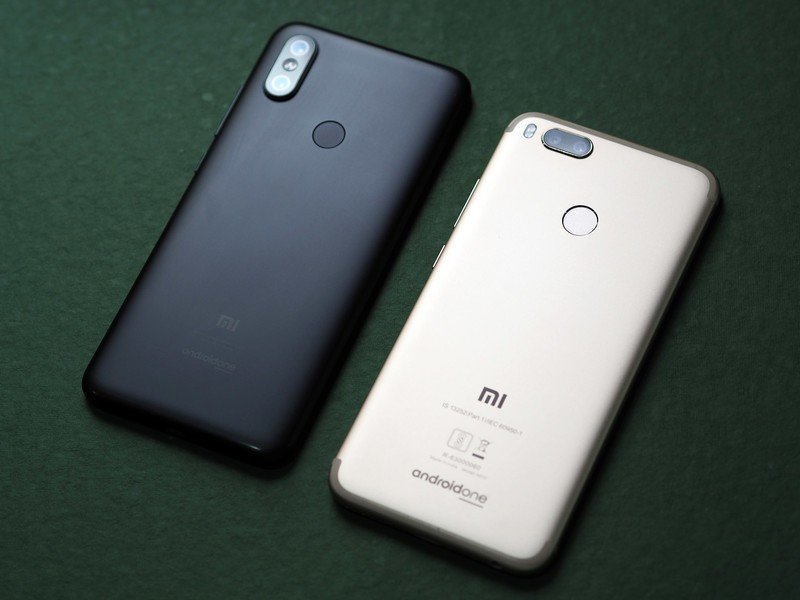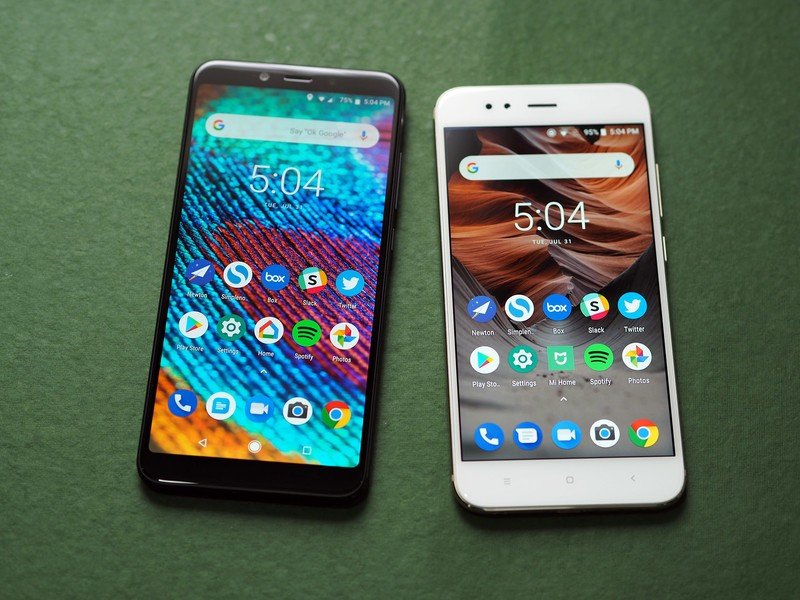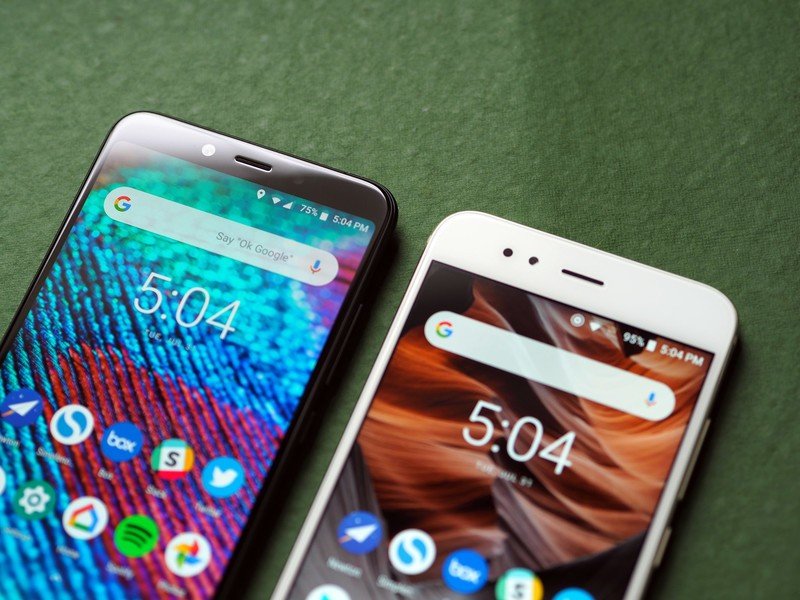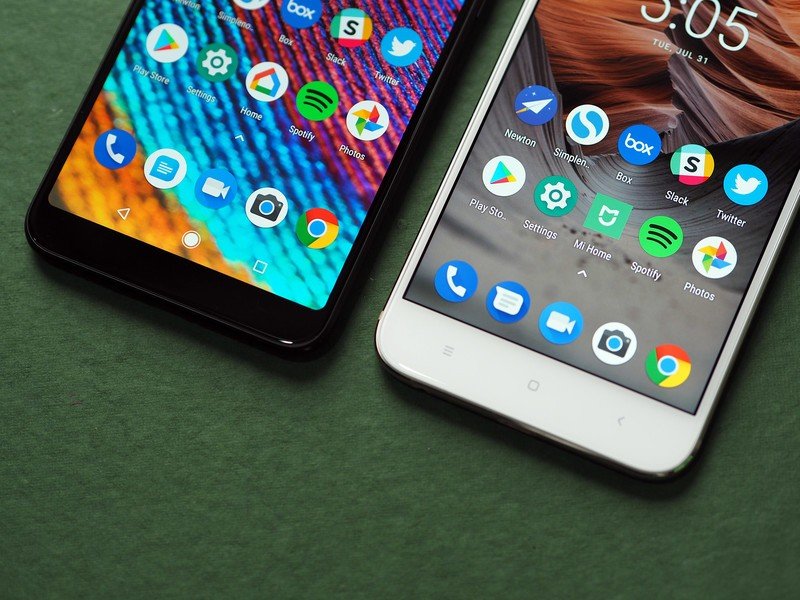Xiaomi Mi A2 vs. Xiaomi Mi A1: Should you upgrade?

The Mi A1 launched last year for the equivalent of $230, and the Mi A2 is slated to make its debut at around the $280 mark. What set the Mi A1 apart from the smorgasbord of Xiaomi phones available in this segment was the fact that it ran Android One instead of MIUI, and that allowed the device to become a fan-favorite in the budget segment.
Xiaomi is retaining the same formula with the Mi A2, but the phone does offer upgraded hardware and much better cameras. The Mi A2 will be available in over 40 markets around the world, so it's time to find out if it's a worthy successor to one of the best budget phones of 2017.
Xiaomi Mi A2 vs. Mi A1: Specs
| Category | Xiaomi Mi A2 | Xiaomi Mi A1 |
|---|---|---|
| Operating System | Android 8.1 Oreo Android One | Android 8.1 Oreo Android One |
| Display | 5.99-inch 18:9 FHD+ (2160x1080) IPS LCD panel Gorilla Glass 5 | 5.5-inch 16:9 FHD (1920 x 1080) IPS LCD panel Gorilla Glass |
| SoC | Octa-core Qualcomm Snapdragon 660 4x2.2GHz Kryo 260 + 4x1.8GHz Kryo 260 14nm | Octa-core Qualcomm Snapdragon 625 Eight Cortex A53 cores up to 2.0GHz 14nm |
| GPU | Adreno 512 | Adreno 506 |
| RAM | 4GB/6GB | 4GB |
| Storage | 32GB/64GB/128GB | 64GB |
| MicroSD slot | No | Yes, up to 128GB |
| Rear camera | 12MP (f/1.75, 1.25um) + 20MP (f/1.75, 1.0um) PDAF, LED flash, 4K video recording | 12MP (f/2.2, 1.25um) + 12MP (f/2.6, 1.1um) PDAF, LED flash 1080p video recording |
| Front camera | 20MP (f/1.75, 2.0um) AI portrait mode LED Selfie light Beautify 4.0 | 5MP f/2.2 lens |
| Connectivity | LTE with VoLTE Wi-Fi 802.11 ac, Bluetooth 5.0 GPS, GLONASS | LTE with VoLTE Wi-Fi 802.11 a/b/g/n, Bluetooth 4.2 3.5mm audio jack GPS, GLONASS |
| Battery | 3010mAh battery Quick Charge 4.0 (India) QC3.0 (ROW) USB-C | 3010mAh battery Quick Charge 3.0 USB-C |
| Fingerprint | Rear fingerprint | Rear fingerprint |
| Dimensions | 158.7 x 75.4 x 7.3mm | 155.4 x 75.8 x 7.3mm |
| Weight | 166g | 165g |
| Colors | Black, Gold, Blue, Rose Gold | Black, Gold, Rose Gold |

What's the same
At its core, the Android One initiative is all about providing a clean user experience. The Mi A2 comes with Android 8.1 Oreo out of the box, and Xiaomi says it will deliver the Android P update shortly after it becomes available.
Things haven't changed on the software front, and that's a good thing.
The fact that the Mi A1 offered a pure Android skin in lieu of MIUI was what made the device such an enticing option last year, and the Mi A2 continues that tradition. There isn't a shortage of budget phones that offer great hardware — Xiaomi itself has plenty of decent options available — but more often than not, most devices in this category don't receive timely updates.
Motorola's Moto G series stood out for that reason, but the current Moto G6 series doesn't hold a candle to what Xiaomi, Honor, and others are offering in this space.
Battery life is also unchanged from last year. The Mi A2 has a 3000mAh battery — a smidgen less than the 3010mAh battery on the Mi A1 — and you'll get a day's worth of usage most of the time. I've been using the Mi A2 for nearly a week, and I'm yet to see the battery go below 10% even after heavy use.

What's different
The key difference between the Mi A1 and its successor is the internal hardware. The Snapdragon 625 chipset in the Mi A1 didn't set benchmark scores on fire, but it was well-regarded because of its balance between efficiency and performance. The Snapdragon 660 on the Mi A2, meanwhile, is one of the fastest chipsets available in this segment.
Get the latest news from Android Central, your trusted companion in the world of Android
The performance on offer with the Snapdragon 660 is on par with the likes of the Snapdragon 820, and the chipset is essentially using the same cores, albeit clocked lower. The Mi A2 also comes with a memory upgrade, and you'll be able to pick up a variant with 6GB of RAM and 128GB of storage.


The upgrade in storage comes in handy as the Mi A2 is losing the MicroSD card slot. The Mi A1 had a hybrid SIM card tray that lets users slot in a secondary SIM card or a MicroSD card, but the Mi A2 doesn't have a provision for the same.
Also missing on the device is the 3.5mm jack, as Xiaomi looks to move away from the port entirely. The brand says the decision to remove the jack was borne out of a need to free up internal space, and it is the one area where the Mi A2 is found lacking when seen against its predecessor.
The Mi A2 is one of the fastest phones you'll see in this segment.
Things haven't changed much up front in terms of quality, and the 5.99-inch IPS LCD panel continues to be one of the best in this category. The switch to an 18:9 form factor has allowed Xiaomi to cram more screen into a body that's roughly the same size as the Mi A1, and that's always a good thing. Furthermore, the Mi A2 finally gets rid of hardware navigation keys, which stuck out like a sore thumb on the Mi A1.
On the subject of improvements, Xiaomi has mentioned that it will offer Quick Charge 4.0 support exclusively for Mi A2 units sold in India, with global units coming with QC3.0 as standard. We haven't seen a lot of phones with QC4.0 in the market — and definitely not in this segment — and the move is a welcome one. That said, there's a lack of wall chargers that deliver QC4.0 speeds, and your best bet is to find a USB-PD charger that goes up to 45W. For its part, Xiaomi is including the standard 5V/2A charger in the box.
Finally, the one reason to consider the Mi A2 over the Mi A1 is the camera. The dual 12MP + 20MP cameras at the back do a fantastic job both in daylight and low-light scenarios, and the 20MP front shooter is the best Xiaomi has included on a phone to date.

Should you upgrade?
The Mi A1 has aged well, but the Mi A2 features considerable hardware upgrades, and the camera is likely to be one of the best yet on a $300 phone. Then there's the fact that the phone is set to debut for just $50 more than the Mi A1, making it an even more attractive option.
If you're using the Mi A1 and are looking for a phone with more robust hardware and an 18:9 panel, then the Mi A2 is a no-brainer. With the phone set to launch in India on August 8, we should know more about pricing and availability shortly, so stay tuned.

Harish Jonnalagadda is Android Central's Senior Editor overseeing mobile coverage. In his current role, he leads the site's coverage of Chinese phone brands, networking products, and AV gear. He has been testing phones for over a decade, and has extensive experience in mobile hardware and the global semiconductor industry. Contact him on Twitter at @chunkynerd.
